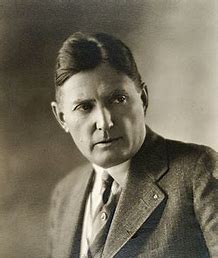
Frank Tenney Johnson was among the most reflective, introspective artists ever to paint the West. His love for the vanishing West of the cowboy was perhaps engendered in him by the close proximity of his birthplace near Council Bluffs, Iowa, to the Overland Trail. Even as a young man Johnson sensed that his career would have to be that of an artist of the Old West.
In 1895 Johnson made his way to New York, where he eventually studied at the Art Students League and with such fine art notables as J.H. Twachtman, Robert Henri and William Merritt Chase. His first professional work came to Johnson in the form of illustration commissions for Zane Grey novels and for Field and Stream and other periodicals. In many ways, however, his first professional work came in the form of a 1904 trip to Colorado and the Southwest, a trip that Johnson was to make many times in his life. The trip seemed to bring into focus an impression of the Old West that made Johnson famous.
Johnson was an excellent draftsman. He used the best materials available to an artist. As did others, Johnson painted with brush, knife and fingers. Above all, Johnson painted scenes of the West that were tableau-like; he rendered romantic, poetic Western genre scenes that differed entirely from the stop-action, narrative works of his contemporaries, C.M. Russell and Frederic Remington. Johnson painted scenes that reflected his preference for non-violent subjects, scenes that showed the cowboy, the Indian or the Spanish settler in a pastoral context. Among these quiet, philosophical canvases two types stand out: his paintings of horses and his night scenes.
Eventually, Johnson became a renowned artist with studios in Los Angeles; Cody, Wyoming; and New York. He was collected by major institutions including the National Gallery of Art in Washington, D.C.; the Royal Palace in Copenhagen; and Fort Worth's Amon Carter Museum. In 1937 Johnson became an Academician of the National Academy of Design.
At the peak of his career Johnson's life came to an unusually unfortunate end. In December, 1938, Johnson attended a party, where he gave a social kiss to his hostess. Within two weeks' time, both were dead of spinal meningitis. In Frank Tenney Johnson's death, the United States lost one of the most accomplished artists ever to love the Old West.